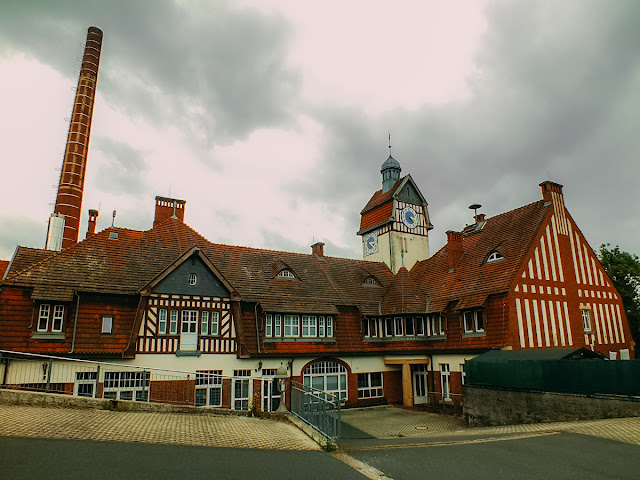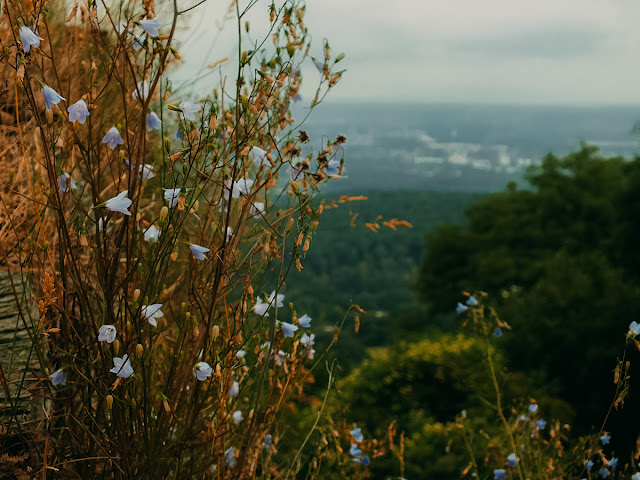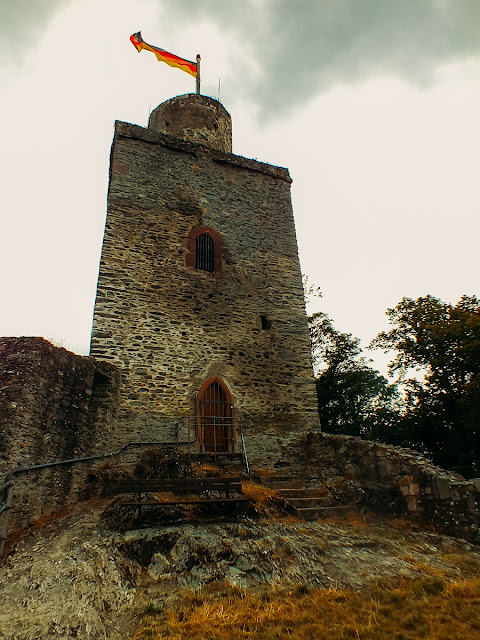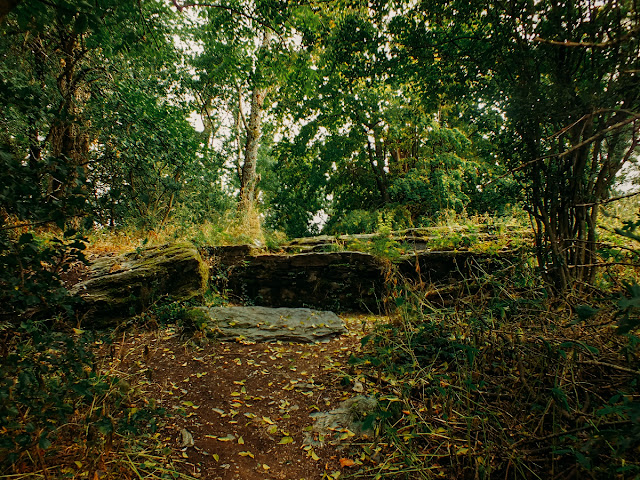discovering an art nouveau inspired domestic yard in falkenstein.
falkenstein is a district of königstein, a spa town in the taunus mountains near frankfurt. on a very muggy and sticky summer day i made my way there to check out falkenstein castle, an old ruin that sits high above the rhein/main plains and overlooks it majestically. as soon as you'll see the pictures you will understand why i chose the falcon image in the title of this post. before i climbed up burghain hill where the castle ruins are situated i stumbled upon another interesting structure - the former domestic yard of a sanatorium for officers. i didn't know that back then when i visited falkenstein, instead i kept wondering what it was. now that i know that it belonged to the sanatorium i regret not checking out more of the actual location, because the sanatorium is still standing as well and used as a very luxurious hotel. well, anyway, i still swooned over finding this seemingly 'hidden' gem and took a few photos before moving on to climb up to falkenstein castle.
the domestic yard was built 1907, a time were art nouveau was all the rage. it is inspired by english manor houses in tudor style though, but some details clearly carry the art nouveau touch.
this is actually the one of the 'back sides' of the yard, don't ask me why i did not check our the rest of it xD clearly sometimes i can't be bothered to investigate 😂 the clock tower, by the way, is a 100 percent art nouveau construction ( in my humble opinion ;) ), and details like the round window on the ground level and generally the vaulted roof parts are also proof of what it was inspired by.
clock tower zoomed in.
anyway, since i was mainly there to climb the burghain hill to check out the castle of falkenstein, i continued to move on and tackled the ascend. it was an overcast day, but don't let that fool you, because it was warm and humid and ascending the hill was quite wearisome. every once in a while i stopped to catch my breath ( the hill is pretty steep! ). but it was really worth the effort, because what awaited me was a view that is pretty hard to underappreciate. ( btw, you need to pay a little entrance fee of 2 euro when you visit from april to october, in november until march the castle grounds are closed ).
falkenstein castle was first mentioned in 1364, but the tower and most of the walls you see on the site date back to the 15th century. it first belonged to the lords of bolanden-falkenstein, but in very close succession many other noble families also called it their own, until in the 18th century it was left to decay and and destruction ( used as a stone pit for the nearby inhabitants of falkenstein and königstein ) because it lost its importance. it is said that some robber-knights also used the castle as their headquarters for their raids at some point. from the grounds of falkenstein you have a pretty awesome view on the rhine/main plains below, of course, as you are 450 meter above sea level. the day i visited the view was not as sweeping as it could've been, because on the horizon towards frankfurt there were lots of rain clouds on the go, shrouding the skyscrapers of this big city in a rather dramatic way. BUT i think, no matter when you visit this place, and no matter what kind of weather it is, you will probably still stand in awe and enjoy the views nonetheless. it is always a humbling sight to look down onto plains from a high-vantage point, but when a big city is involved in that view, it is doubly fascinating.
before i show you the views, let's check out the castle grounds some more. old trees were growing on the premises, something i always appreciate, especially when they grow in a special way.
there's remnants of 3 more towers on the site, having been added in the 15th century. they had a diameter of 10 meters and the walls were about 3 meters thick.
tiny crenel.
the castle was heavily reinforced towards the west, which was the main attack side, as the approach to the castle was a lot more flat and levelled than the rocky and steep slope on the eastern side. the frontal wall around the premise is preserved well, other buildings like residential dwellings inside the inner bailey aren't and only some foundational walls still indicate their former location.
tiny farns growing on rocks 💚 this is a special one called maidenhair spleenwort. love the name!
i absolutely adore it when a plant grows somewhere it shouldn't technically be able to 💚
those openings were much too small to be windows, but windows to the outside they were nonetheless, even if that meant that someone would probably be shot at 😅
a look back towards the tower. the rectangular bit actually dates back to the 14th century, and the butter tub bit on top is the 15th century part. together with the extension the tower has a height of 18 m. it stands on the highest part of the castle premises on rocky bedrock. it cannot be entered, but occassionally the club that maintains the facility opens it up on special days.
approaching the side where once there stood the residential area you already get a glimpse of what the views are like and why it's not such a dismissive thing to imagine falcons hovering over the precipices. falcons love high vantage points and places like this are the perfect habitat for them. unfortunately, though, i haven't consciously seen any flying around.
getting closer to the tower. crazy how people in the middle ages were able to build something so sturdy on massive rocks like these.
i think these were rampion bellflowers growing on the curtain walls.
and here is a very cool view of frankfurt and its surrounding communities! frankfurt hides itself in a thick mist of rain, you can only apparitionally see the bankenviertel with its many highrises. on the left side of the image you can see the distinct europaturm ( tower of europe ), another landmark of frankfurt, the second highest telecommunications tower, after the berlin fernsehturm, in germany. it is 337.5 meters high! in the front ( the cluster of buildings ) is the city of kronberg, a very expensive pavement to live on ( such as königstein ) ;)
a litte more zoom reveals kronberg more and also lets you discover kronberg castle. there are more communities to be seen here, i think the location in the woods behind the big industrial complex is niederhöchstadt, a district of eschborn.
i shot the pictures of the rhine/main plains from within the former living quarters on the castle. whoever lived here in history for sure had a really amazing view ( though of course there weren't any highrises and mammoth cities to be seen 😂 )
discovered a ladybug crawling on a very spike-y plant!
 when the field milk thistles explode into fluffy and wooly balls 😍
when the field milk thistles explode into fluffy and wooly balls 😍from this side you could technically enter the tower. the opening above the ground level entrance was actually the main way to enter the tower ( i guess there was a wooden staircase leading up to it ). on the left side there's a wall that was probably once belonging to an ajar building, though it's not clear what it was.
directly underneath the tower you can sit on this bench and enjoy the view on the rhine/main plains even more! though it was hazy on that day because of the brewing rain clouds everywhere, i still appreciated that view very much! on clear days you can probably see as far as to the odenwald/spessart mountains ( not confirmed, but i wouldn't be surprised ^^; ).
i want y'all to also appreciate these lovely bedrocks! gotta love this stratification!
view down on falkenstein ( the village ). i personally felt like a falcon seeing all this 😂 without wind under my wings, though. that would've been even nicer!
stairs back down to the inner bailey. for people with vertigo, this might not be a good location to visit 😳
i left the castle premises to explore the surroundings a little bit more. this is the main entry, where you can still see the remains of one of the half towers ( and the donjon of course! ).
another one of those massive half tower fundaments / bastions.
right around the corner of falkenstein castle you will come upon more remains of a structure - but it is not something that is linked to it. instead, these fundaments are from an older castle that stood not far away from the falkenstein one.
castle nürings it was called ( or norings ) and the only thing that still remained of the castle are the foundational stones of a residence tower. on this plaque it says that this was a tower butt of a salian castle, so probably built around the 11th century, but recent research has found out that the structure is probably of a later date ( 13th to 15th century - which would then fall into the time of the falkenstein castle activities ).
whatever the truth is, these foundations are old nonetheless ;) and i suppose that falkenstein castle probably even got built with construction material from this old relict.
the outer walls of the tower.
continueing to explore...
... and finding a look-out temple from 1896! the dettweiler temple sits on a part of a rock that is sometimes called 'teufelskanzel' ( devil's pulpit ) or 'huchlay' ( i reckon it comes from hoch liegen, resting high ). the bedrock is really smooth here, probably from millions of people wearing it down over the centuries. the dettweiler temple was named after a pulmonologist called peter dettweiler, who practiced in the sanatorium in falkenstein i talked about earlier.
from here you can also enjoy the views over the rhine/main plains, and in addition to the aforementioned possibilities of maybe even seeing the spessart and odenwald mountains you can also have views towards the wetterau landscape and vogelsberg mountains in the north east. let me tell you, the thundery and sultry weather was most perceptible on this little piece of rock!
i did not want to get struck by a lightning, so i eventually returned to the woods 😂 loved how the builders of the dettweiler temple managed to work the rock in such a way that they were able to create steps!
back in the woods i felt like i was in a jungle again! don't ask me what the tag means, though, it surely wasn't a sign to lead you to a special place 😅
or maybe it was, but i didn't realize? maybe it's a fantastical place and i was just too unimaginative to find it?
a rocky path might have been an indicator to the lands of 'shigat'?
whatever it was, i still only encountered a jungle.
or was shigat actually a little beetle on the ground? maybe shigat was the land of the dor beetles?
or the land of the wax fungi?
on this ledge i sat down and dangled with my feet a bit, until i heard a rustling sound. when i turned around i saw a deer hurrying away from me a few meters away. i didn't really realize it at first, that it was actually a deer, but the white fur on its buttocks gave it away quickly as it ran away. and then the surprise kicked in and i internally squealed upon the sight. i sat really quietly as it stopped for a second and looked back at me again, before it finally disappeared. you guys have no clue how much encounters like this feel absolutely blessed to me. moments like these can never be properly be documented, you just have to experience them and be grateful for what they are - fleeting, but also memorable and full of joy. and maybe... shigat was the land of the deer ❤
the deer disappeared through these tree gates, which in retrospect i felt was adding even more to the magical image!
quiet chaos, listening to sounds of crickets hiding in the high growth.
while it might be a sad sight to see trees fallen, one is also reminded that even trees cannot live forever and their death provides soil for new growth, changing and creating new chances to adapt and evolve.
i had to crawl through this entanglement of twigs and branches, it really did feel like i was on a jungle quest at times 😅
at the end of the path i emerged on the other side of burghain hill, with a view onto königstein and its castle. rain was approaching fast, but i was in luck, it did not start to rain until i finally returned to my car like an hour later! talk about being blessed!
the castle ruins of königstein, looking over the city at around 400 meter above sea level. it was built somewhen before 1200, the research is still unsure about when exactly this happened. some parts date back even to the 10th century. there is a legend that king chlodwig ( lived in the 4th/ 5th century) came upon the holy virgin while he passed by the hill, turning him into a christian and to show his gratitude he erected a castle on the hill. there's no evidence, though, that might back this legend up. it's more likely that the lords of nürings first erected a castle on the hill. the falkenstein lords continued to enhance and secure the castle after the nürings died out, and other lords and governors would do the same in the next centuries to come. it became a ruin during the coalition wars ( around the time of the french revolution ), when the french army occupied it and later on even tried to completely blast it to crumbles ( in 1796 ). after that date the citizens of königstein needed material to rebuild their devastated homes, so like many castles everywhere in germany, königstein castle also became a stone quarry. that only stopped in the 19th century when adolphe, grand duke of luxembourg acquired the castle ruins.
in a different direction you could see the turrets and tower of another special building in königstein: villa andreae. this villa once belonged to the very rich financier albert andreae de neufville from frankfurt and was built in 1891.
back into the woods i went, i still had a bit to walk and the rain clouds were getting closer and closer, and the humidity got worse.
which did not stop me to take some quick nature shots, though 😂 dead nettle blossoms!
i re-emerged at the foothill of the burghain, directly behind the kurbad ( spa ) of königstein. this blue sweetheart is one of my favourite buildings in the city, a brutalist construction that is untypically non-brutalist in its colouration! it was built in 1977 by rudolf and ingeborg geier, with the help of the artist otto herbert hajek. some of you remember that i am a big fan of mister hajek, he also worked in wiesbaden on the magnificient st. mauritius church ( which i introduced here ). i re-visited this gem in the spring of 2020, so i will not get into detail here any further ( i still want to have something to tell, when we get to that 😂 ), but let me tell you, it's a real piece of art. thank goodness it is a listed monument since 2013, so hopefully it'll still be around for a while. i hope to return yet again, as soon as corona is not disturbing any swimming plans anymore, so i can eventually get a glimpse again from within the spa!
i love the triangular patterns on the building, and the stark contrast of the blue and ( actually ) orange. hajek is widely known for his use of geometric patterns, and he really managed to always create something that would ensure a passerby to stop and gawk and wonder over it. and his work is instantaneously recognizable!
balcony details.
even from the back side of the building, it still is a real showstopper. oh, and can you glimpse the castle ruins? you have a great view from the outside pool towards the castle, it's really special.
not far away from the spa, this dude raised his hand to greet me: ernst majer-leonhard. he was an educator and principal of several secondary schools in the frankfurt region and also initiated the taunusgymnasium in königstein. he's somewhat of a humanistic hero, he fought against nazi restrictions for example.
passed by some more rocky formations on my way back to falkenstein.
no, i will never get tired of these folded greenschists!
how could one ever get tired? these formations are utterly and completely romantic in my opinion 😍
stumbled upon a gorgeous art nouveau villa from 1902! it seems to be the only 'real' art nouveau building in königstein, other buildings from the same era only have little details to offer or are more traditionally oriented. many buildings were built in a more historicizing fashion and seem to rarely have incorporated new styles fully like this art nouveau gem. it's so playful, though and emits such a joie de vivre, don't you think? crazy to think that people didn't like this frivolous style secretly ;)
detail shot. even the lettering of the villa, stephanie, was executed in an art nouveau character. the swirly decor is also typical for art nouveau architecture. i also loved the colour combination!
the timber-framed gable part was gorgeous! usually, timber-framed constructions don't use such elaborate patterns or play with images even.
i left königstein for good and returned to more natural pastures. isn't this little scenery so idyllic?
and i loved this garden shed so much! like a tiny witch cottage it stood there. i wish garden sheds would look like this more often, like tiny medieval houses ❤
i love exploring these parts of the taunus mountains ( königstein and falkenstein are situated in the hochtaunus - high taunus ), there's lots of interesting history and architecture to discover there, it's a diversified region that combines tradition and modern living very well and it's also so scenically precious! everytime i visit the hochtaunus i get charmed again and again! and rest assured, i'm gonna visit even more places in the future. stay curious!



































































Comments